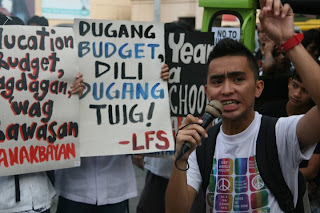Repost from Kamalayan in Facebook
 |
Image by: Ang Gerilya
OUR HISTORY: FROM PEOPLE POWER TO TODAY
|
In the Philippines, pork barrel funds have been in use at least since the 1930s during the U.S. colonial occupation. Wrote Patricio Diaz in a column for MindaNews: “The spoil system originated from American politics. Just like today, appointive positions then were the preserve of the party in power. These positions, like today, were used to pay political debts.
“The pork barrel in Congress was part of this spoil system. In fact, in the 1930s, pork barrel was like the personal discretionary fund of the members of the Legislature who belonged to the ruling party.”
The pork barrel in the Philippines has assumed various names, most probably because of the term’s less-than-savory connotations. During the presidency of Fidel V. Ramos (1992-1998), it was known as the Countrywide Development Fund (CDF). It is presently known as the Priority Development Assistance Fund (PDAF).
In 2013 the budget allocation for the PDAF is P25.2-billion--and as of 25 August 2013, budget Secretary Florencio Abad has confirmed that this figure will remain the same for 2014.
“By whatever name and method, “Diaz further wrote, “the pork barrel today has the same ultimate purpose as in the 1930s: privileged politicking by the incumbent at the expense of the government. And, let's be candid about it: in the past, assemblymen spent their pork barrel the way they wanted to; essentially, it's the same today.”
~ ~ ~
The Philippine Center for Investigative Journalism (PCIJ), in its 1998 book Pork and Other Perks, reported that pork-funded projects “do not undergo the usual process of evaluation to determine their feasibility.”
Because they are not subject to evaluation, such projects are prone to overpricing. The PCIJ book cites a 1996 report by the Commission on Audit (CoA) revealing that “In some cases, the extent of overpricing reached more than 200 percent of the market prices and government-set costs.”
The book quotes directly from the CoA report thus: “It is alleged that the proponent legislator connived with the government officials concerned, and the supplier and contractor to obtain the commissions, ‘standard operating procedures,’ or kickbacks from the transaction.”
Through much of contemporary Philippine history, the pork barrel has served mostly as a way for presidents to corrupt politicians to win their loyalty and get them to support particular political agendas. In the allocation of the pork barrel, corruption is directly tolerated by the higher-ups to secure the support of politicians, especially those who are closer to the local communities whence votes come.
In the late 1940s, for instance, President Manuel Roxas dangled pork barrel funds to congressmen as a way of winning their support for the Bell Trade Act. The Bell Trade Act gave American corporations equal “rights” with Filipino businessmen in exploiting the country’s economic resources, even as the latter had the advantage of greater capital.
It required a 2/3 vote to pass, and there were six representatives from the Left-led Democratic Alliance (DA) who constituted a block on the bill. Roxas also used pork barrel funds to entice other representatives to support the dubious charges of “electoral terrorism” filed against the DA representatives.
The bill managed to be enacted.
~ ~ ~
The pork barrel originated in the U.S., but it is not so clear when. But it was already in use as early as 1817, when South Carolina Rep. John Calhoun introduced a Bonus Bill. The bill sought to construct highways connecting the eastern and southern parts of the U.S. to its western frontiers using the earnings Bonus from the Second Bank of the United States.
Sources:
http://www.bulatlat.com/
http://

Sadly Rich Are Still Getting Richer and poor get poorer lets just face it!!! Sakit.info
ReplyDelete